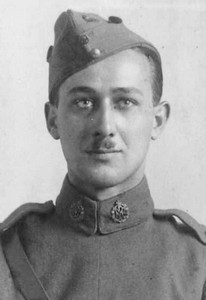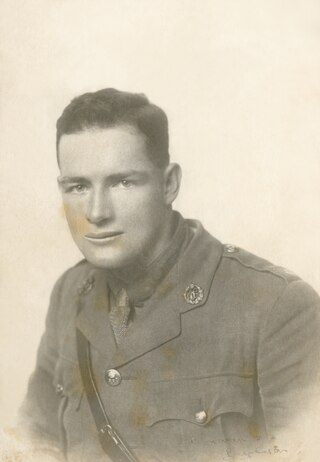Related Research Articles
Captain Leslie William Burbidge was a World War I flying ace credited with six aerial victories. He flew as an observer/gunner in Bristol F.2 Fighters in 20 Squadron.
Lieutenant William Charles Cambray was a World War I flying ace credited with six aerial victories won while flying as an observer/gunner in two-seater aircraft.
Lieutenant Thomas Archibald Mitford Stuart Lewis was a British World War I flying ace credited with six aerial victories.
Flight Lieutenant William Geoffrey Meggitt was a British World War I flying ace credited with six aerial victories.
Squadron Leader Victor Rodney Stokes White (1895–1967) was an English World War I flying ace credited with six aerial victories. He returned to military service during World War II.
Lieutenant Colonel Alan Machin Wilkinson was a British First World War flying ace credited with nineteen aerial victories. He was one of only about 25 pilots twice awarded the DSO during the war, five of whom were also holders of the Victoria Cross.
Flight Lieutenant David Arthur Stewart, was a British First World War flying ace credited with sixteen aerial victories. Remarkably, they were all scored while he was flying bombers instead of fighters.
Squadron Leader Anthony Herbert William Wall was a British World War I flying ace credited with sixteen aerial victories. He returned to serve in the Royal Air Force in World War II.

Captain Douglas Graham Cooke was a British World War I flying ace credited with thirteen aerial victories.
Lieutenant Ernest Hardcastle was an English World War I flying ace observer/gunner credited with twelve aerial victories. He would return to military service during World War II.
Group Captain Campbell Alexander Hoy was a British flying ace during the First World War, credited with eleven aerial victories. He remained in the Royal Air Force post-war and served through the end of the Second World War.
Second Lieutenant Maurice Edmund Mealing MC was a World War I flying ace credited with 14 aerial victories.
Captain Thomas Laurence Purdom was a Scottish World War I flying ace credited with 13 confirmed aerial victories.
Laurence Wilfred Allen was an English World War I flying ace. He was credited with ten confirmed victories while serving as an observer/gunner in Bristol F.2 Fighters.

Lieutenant Croye Rothes Pithey was a South African World War I flying ace credited with 10 aerial victories. He was one of the war's handful of bomber pilots to become a balloon buster; he may have been the only pilot to do it twice. He was also celebrated for his feats of visual and photographic reconnaissance under hazardous circumstances.
Francis Dominic Casey, was an Irish flying ace of the Royal Naval Air Service during the First World War, credited with nine aerial victories. He received the Distinguished Service Cross before his death during a test flight in 1917.
Lieutenant Ronald William Turner, was an English World War I flying ace. He was credited with nine aerial victories while flying as an observer/gunner in two-seater fighters.
Captain John William Aldred was an English World War I flying ace credited with eight aerial victories. He began military service in World War I as an infantryman and transferred to flight duty as an observer. After scoring two aerial victories and winning the Military Cross, he qualified as a fighter pilot, scored six more triumphs, and earned a Bar to his MC in lieu of a second award.
Captain Jeffery Batters Home-Hay was a Scottish-born Canadian who became a flying ace during World War I. He was a bomber pilot when he was credited with seven aerial victories. He was shot down and captured toward the end of World War I. After being repatriated, he became a pioneering Canadian bush pilot. By the end of his aviation career, he was the oldest pilot still flying in Canada.
Captain William Thomas Price was a World War I flying ace who hailed from Warwickshire, England. He was credited with seven aerial victories at a time when British aviation was suffering its heaviest casualties of the war. After leaving military service, he devoted his life to teaching agriculture until his retirement in 1962.
References
- 1 2 3 4 Franks, Norman; Guest, Russell; Alegi, Gregory (15 September 1997). Above the War Fronts: A Complete Record of the British Two-seater Bomber Pilot and Observer Aces, the British Two-seater Fighter Observer Aces and the ... and Russian Fighter Aces (Air aces of WWI). Grub Street. p. 5. ISBN 978-1898697565.
- 1 2 "No. 30040". The London Gazette (Supplement). 30 April 1917. p. 4077.
- ↑ "No. 30188". The London Gazette (Supplement). 18 July 1917. p. 7221.
- ↑ "No. 31486". The London Gazette . 1 August 1919. pp. 9864, 9868–9.
- ↑ "No. 31678". The London Gazette . 9 December 1919. pp. 15196–7.
- ↑ "No. 31539". The London Gazette . 5 September 1919. p. 11245.